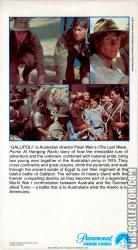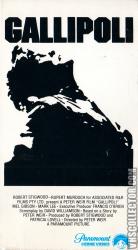Gallipoli
Catalog Number
1504
-
Primary Distributor (If not listed, select "OTHER")
Catalog Number
1504
Primary Distributor (If not listed, select "OTHER")
Release Year
Country
N/A (NTSC)
N/A | N/A | N/A
N/A | N/A
Gallipoli (1981)
Additional Information
Additional Information
Peter Weir's film of...Gallipoli
From a place you never heard of...a story you'll never forget.
The first of two consecutive films to see director Peter Weir team with Mel Gibson (the other being The Year of Living Dangerously), Gallipoli follows two idealistic young friends, Frank (Gibson) and Archy (Mark Lee), who join the Australian army during World War I and fight the doomed Battle of Gallipoli in Turkey. The first half of the film documents the lives of the young men in Australia, detailing their personalities and beliefs. The second half of the movie chronicles the ill-fated and ill-planned battle, where the Australian and New Zealand Army Corps is hopelessly outmatched by the enemy forces. Gallipoli was the recipient of eight prizes at the 1981 Australian Film Institute Awards
Gallipoli is a 1981 Australian film, directed by Peter Weir and starring Mel Gibson and Mark Lee, about several young men from rural Western Australia who enlist in the Australian Army during the First World War. They are sent to the peninsula of Gallipoli in the Ottoman Empire (in modern day Turkey), where they take part in the Gallipoli Campaign. During the course of the movie, the young men slowly lose their innocence about the purpose of war. The climax of the movie occurs on the Anzac battlefield at Gallipoli and depicts the futile attack at the Battle of the Nek on 7 August 1915.
Gallipoli provides a faithful portrayal of life in Australia in the 1910s—reminiscent of Weir's 1975 film Picnic at Hanging Rock set in 1900—and captures the ideals and character of the Australians who joined up to fight, as well as the conditions they endured on the battlefield. It does, however, modify events for dramatic purposes and contains a number of significant historical inaccuracies.
It followed the Australian New Wave war film Breaker Morant (1980) and preceded the 5-part TV series ANZACs (1985), and The Lighthorsemen (1987). Recurring themes of these films include the Australian identity, such as mateship and larrikinism, the loss of innocence in war, and the continued coming of age of the Australian nation and its soldiers (later called the ANZAC spirit).
The numerous running sequences in the film are set to Jean Michel Jarre's Oxygène.
Release Date: August 28, 1981 @ the Coronet
Distrib: Paramount
Boxoffice: $5,732,587 2013: $16,372,900
From a place you never heard of...a story you'll never forget.
The first of two consecutive films to see director Peter Weir team with Mel Gibson (the other being The Year of Living Dangerously), Gallipoli follows two idealistic young friends, Frank (Gibson) and Archy (Mark Lee), who join the Australian army during World War I and fight the doomed Battle of Gallipoli in Turkey. The first half of the film documents the lives of the young men in Australia, detailing their personalities and beliefs. The second half of the movie chronicles the ill-fated and ill-planned battle, where the Australian and New Zealand Army Corps is hopelessly outmatched by the enemy forces. Gallipoli was the recipient of eight prizes at the 1981 Australian Film Institute Awards
Gallipoli is a 1981 Australian film, directed by Peter Weir and starring Mel Gibson and Mark Lee, about several young men from rural Western Australia who enlist in the Australian Army during the First World War. They are sent to the peninsula of Gallipoli in the Ottoman Empire (in modern day Turkey), where they take part in the Gallipoli Campaign. During the course of the movie, the young men slowly lose their innocence about the purpose of war. The climax of the movie occurs on the Anzac battlefield at Gallipoli and depicts the futile attack at the Battle of the Nek on 7 August 1915.
Gallipoli provides a faithful portrayal of life in Australia in the 1910s—reminiscent of Weir's 1975 film Picnic at Hanging Rock set in 1900—and captures the ideals and character of the Australians who joined up to fight, as well as the conditions they endured on the battlefield. It does, however, modify events for dramatic purposes and contains a number of significant historical inaccuracies.
It followed the Australian New Wave war film Breaker Morant (1980) and preceded the 5-part TV series ANZACs (1985), and The Lighthorsemen (1987). Recurring themes of these films include the Australian identity, such as mateship and larrikinism, the loss of innocence in war, and the continued coming of age of the Australian nation and its soldiers (later called the ANZAC spirit).
The numerous running sequences in the film are set to Jean Michel Jarre's Oxygène.
Release Date: August 28, 1981 @ the Coronet
Distrib: Paramount
Boxoffice: $5,732,587 2013: $16,372,900






Comments0
Login / Register to post comments